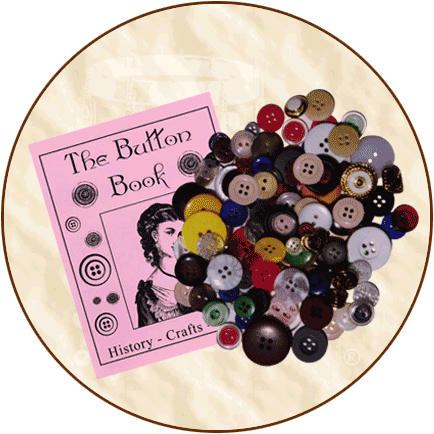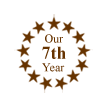.
Continued from product description
on Home Crafts' Page One...
Historical
Background: A button is described as an object that can
be used to fasten clothing. A button either has holes to sew
the button onto the garment or a loop or shank on the back of
the button for this purpose. Buttons have been made from every
possible material found on the earth including iron, bronze,
silver, gold, brass, pewter, shell, mother of pearl, wood, bone,
horn, antler, ivory, glass, stone, leather, ceramic, celluloid,
and plastic. The word "button" comes from the French
word "bouton," meaning "bud" or "knob."
The history of buttons begins in the Bronze Age. There was
no usefulness attributed to buttons then because they were only
used for decorative purposes and not for fastening articles of
clothing. Buttons were found on the 10,000-year-old "iceman"
discovered in the Italian Alps. Ancient Egyptians, Greeks, Romans,
Chinese and pre-Colombian Americans used buttons as decorative
pieces.
The 13th century saw a change in the way buttons were used.
In Western Europe, clothing styles were fitted and buttons were
used to fasten clothing together. Buttons were an expensive item
for most people and were being made of wood, horn, and metal.
By the 14th century, buttons were more of a status symbol and
men would flaunt their clothing with the best, largest, or most
elaborate buttons. During the 16th century, nobility used buttons
made of precious metal, usually gold or silver. Some buttons
were even decorated with delicate paintings. The wealthy began
to spend large sums of money on buttons to show off their finery.
This caused some religious sects to ban the use of buttons. For
the next 200 years, men's clothing featured more buttons than
women's clothing.
In 1750, a German immigrant, Caspar Wistar, began making brass
buttons in Philadelphia, Pennsylvania. Metal buttons imported
from France were used on the uniforms of the Continental Army.
Mass production of buttons began in the 19th century. The
button-making industry is associated with the "golden age
of buttons" -- from 1830 to 1850. By 1860, women were the
main users of the new "novelty" buttons. Queen Victoria
began using jet buttons in 1861 while mourning the death of her
husband, Prince Albert. Others followed suit and soon black glass
was substituted for the jet, which was very expensive. If you
want to know whether you have a jet or black glass button, put
the button in water. Jet buttons float while glass buttons sink.
Fun
Fact: In 1812, Aaron Benedict of Waterbury, Connecticut,
bought up all the pots and pans he could find and used the metal
to make buttons in his mill.
Fun
Fact: Covered buttons are buttons that can be covered
with fabric to match a particular piece of clothing, such as
a shirt or dress.
Fun
Fact: In 1840, rubber buttons were made, but these did
not hold up well and were discontinued.
Fun
Fact: Before brass was used for buttons in the 1920s,
British buttons were made from pewter.
Fun
Fact: Celluloid was developed to replace ivory.
Fun
Fact: Velcro is considered to be like a button in the
usefulness it provides. Velcro fasteners make it easy to put
on and take off clothing used by hospital patients and those
unable to dress themselves with clothing that have traditional
buttons.
Fun
Fact: Most uniform buttons are in a category all by themselves
because they are stamped with the name of the establishment on
the button, such as military, fire departments, police, hotels,
airlines, railroads, schools, banks, as well as city and state
organizations. Livery buttons even existed which bore a family's
coat of arms or crest imprinted on them and were also used on
the clothing of servants.
Fun
Fact: Because buttons can be expensive, many people recycle
the buttons from old clothes to use on newly made garments. A
box of buttons can be found in most households. Rummaging through
old buttons can be a lot of fun, as button collectors know. Button
collecting has become a passion for many people and, in 1938,
the National Button Society was formed.













